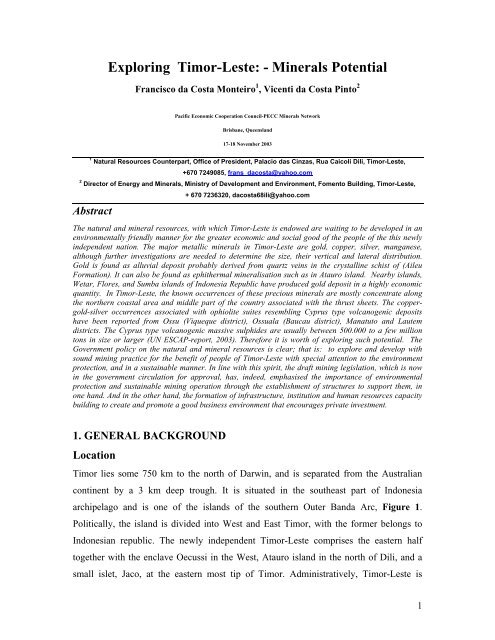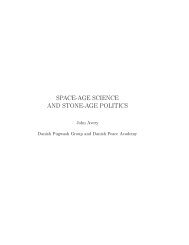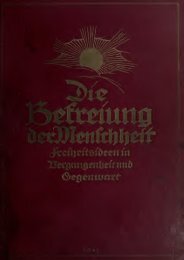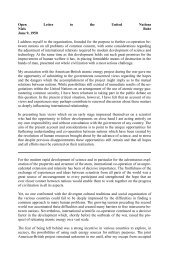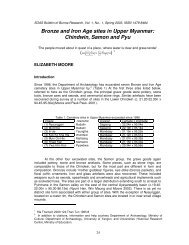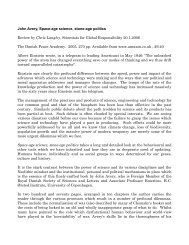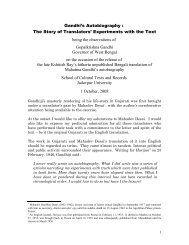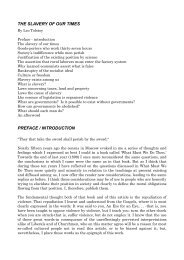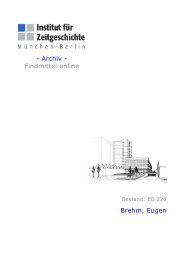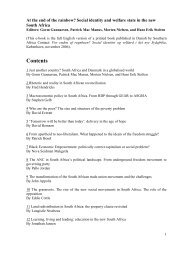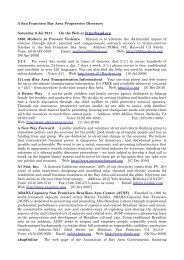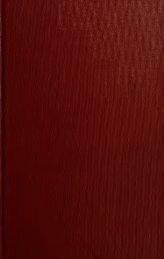Exploring Timor-Leste - The Pacific Economic Cooperation Council
Exploring Timor-Leste - The Pacific Economic Cooperation Council
Exploring Timor-Leste - The Pacific Economic Cooperation Council
Create successful ePaper yourself
Turn your PDF publications into a flip-book with our unique Google optimized e-Paper software.
<strong>Exploring</strong> <strong>Timor</strong>-<strong>Leste</strong>: - Minerals Potential<br />
Francisco da Costa Monteiro 1 , Vicenti da Costa Pinto 2<br />
<strong>Pacific</strong> <strong>Economic</strong> <strong>Cooperation</strong> <strong>Council</strong>-PECC Minerals Network<br />
Brisbane, Queensland<br />
17-18 November 2003<br />
1 Natural Resources Counterpart, Office of President, Palacio das Cinzas, Rua Caicoli Dili, <strong>Timor</strong>-<strong>Leste</strong>,<br />
+670 7249085, frans_dacosta@yahoo.com<br />
2 Director of Energy and Minerals, Ministry of Development and Environment, Fomento Building, <strong>Timor</strong>-<strong>Leste</strong>,<br />
Abstract<br />
+ 670 7236320, dacosta68ili@yahoo.com<br />
<strong>The</strong> natural and mineral resources, with which <strong>Timor</strong>-<strong>Leste</strong> is endowed are waiting to be developed in an<br />
environmentally friendly manner for the greater economic and social good of the people of the this newly<br />
independent nation. <strong>The</strong> major metallic minerals in <strong>Timor</strong>-<strong>Leste</strong> are gold, copper, silver, manganese,<br />
although further investigations are needed to determine the size, their vertical and lateral distribution.<br />
Gold is found as alluvial deposit probably derived from quartz veins in the crystalline schist of (Aileu<br />
Formation). It can also be found as ephithermal mineralisation such as in Atauro island. Nearby islands,<br />
Wetar, Flores, and Sumba islands of Indonesia Republic have produced gold deposit in a highly economic<br />
quantity. In <strong>Timor</strong>-<strong>Leste</strong>, the known occurrences of these precious minerals are mostly concentrate along<br />
the northern coastal area and middle part of the country associated with the thrust sheets. <strong>The</strong> coppergold-silver<br />
occurrences associated with ophiolite suites resembling Cyprus type volcanogenic deposits<br />
have been reported from Ossu (Viqueque district), Ossuala (Baucau district), Manatuto and Lautem<br />
districts. <strong>The</strong> Cyprus type volcanogenic massive sulphides are usually between 500.000 to a few million<br />
tons in size or larger (UN ESCAP-report, 2003). <strong>The</strong>refore it is worth of exploring such potential. <strong>The</strong><br />
Government policy on the natural and mineral resources is clear; that is: to explore and develop with<br />
sound mining practice for the benefit of people of <strong>Timor</strong>-<strong>Leste</strong> with special attention to the environment<br />
protection, and in a sustainable manner. In line with this spirit, the draft mining legislation, which is now<br />
in the government circulation for approval, has, indeed, emphasised the importance of environmental<br />
protection and sustainable mining operation through the establishment of structures to support them, in<br />
one hand. And in the other hand, the formation of infrastructure, institution and human resources capacity<br />
building to create and promote a good business environment that encourages private investment.<br />
1. GENERAL BACKGROUND<br />
Location<br />
<strong>Timor</strong> lies some 750 km to the north of Darwin, and is separated from the Australian<br />
continent by a 3 km deep trough. It is situated in the southeast part of Indonesia<br />
archipelago and is one of the islands of the southern Outer Banda Arc, Figure 1.<br />
Politically, the island is divided into West and East <strong>Timor</strong>, with the former belongs to<br />
Indonesian republic. <strong>The</strong> newly independent <strong>Timor</strong>-<strong>Leste</strong> comprises the eastern half<br />
together with the enclave Oecussi in the West, Atauro island in the north of Dili, and a<br />
small islet, Jaco, at the eastern most tip of <strong>Timor</strong>. Administratively, <strong>Timor</strong>-<strong>Leste</strong> is<br />
1
divided into 13 districts with each district headed by an administrator. Dili is the capital<br />
of the country. <strong>The</strong> climate is tropical, with topography of the island is dominated by<br />
rugged steep sided mountainous terrain to the north and relatively subdues morphology to<br />
the south. Important minerals occurrences are in the middle and north part of the country.<br />
Geology<br />
<strong>Timor</strong>-<strong>Leste</strong> takes half of the <strong>Timor</strong> Island, which is regarded as part of Outer Banda Arc<br />
islands. This arc is non-volcanic arc, except Atauro island the Miocene-Pliocene volcanic<br />
island. <strong>Timor</strong>, based on published tectonic models, is believed to be formed by a complex<br />
of stack thrust sheets accreted over the Australian continental margin deposits during<br />
Middle-Miocene (Audley-Charles, 1968) and Middle-Pliocene (Carter et al., 1976).<br />
Although, due to the complex distribution of rock units as a result of tectonic<br />
disturbances, four distinctive tectonostratigraphic units can be recognised in <strong>Timor</strong>-<strong>Leste</strong>,<br />
Figure 2 & 3. <strong>The</strong>y are:<br />
1. <strong>The</strong> autochthonous units which encompass all the rock units that were deposited<br />
in <strong>Timor</strong> basin (insitu) during and after major orogenesis. <strong>The</strong>se include the Late<br />
Miocene-Pliocene mollase deposits (Viqueque Formation), and Quaternary reefal<br />
carbonates and alluvial deposits (Baucau, Poros, Suai and Ainaro Formation).<br />
2. <strong>The</strong> parautochthonous units that are the relatively coherent pre-collisional<br />
Australian continental margin deposits which were brought to its present position<br />
by the northward drifting of Australian continental plate. This forms athe largest<br />
component of the <strong>Timor</strong> island and indeed <strong>Timor</strong>-<strong>Leste</strong> (e.g., Audley-Charles,<br />
Charlton et al., 1991). <strong>The</strong>y consist of Permian turbidite sandstones and<br />
limestones, and interbedded with basalt (Atahoc and Cribas Formations), Triassic<br />
pelagic limestones (Aituto Formation) and sandstones (Babulu Formation),<br />
Jurassic shales (Wailuli Formation), Cretaceous radiolarite and shales (Waibua<br />
Formation), and Early Tertiary shelf limestone (Dartolu, Borolalo, and Cablaci<br />
Formations), and the pre-Permian metamorphic complex (Lolotoi Formation)<br />
3. <strong>The</strong> allochthons units which are comprised of Permian to Jurassic metamorphic<br />
rocks (Aileu, Maubisse Formations), and possibly some Tertiary Banda Arc<br />
2
Terrains (the Oecussi and Atatapupu volanics, which were detached from the<br />
lower crust and overthrusted onto parautochthonous and autochthonous units.<br />
4. And the olistrostrom units that comprise of variety of unsorted angular to<br />
subangular block of Permian to Early Miocene (occasionally to Late Miocene) in<br />
a scaly clay matrix (Audley-Charles, 1968; Charlton et al., 1991). This unit is<br />
known as Bobonaro Scaly Clay Formation.<br />
Tectonics<br />
<strong>The</strong> tectonic history of the island has been subject to debate for decades, not a single<br />
structural explanation has yet been sufficient to explain all the complexities it has.<br />
However, it is widely accepted that <strong>Timor</strong> was formed as result of collision between<br />
Australian continental plate and Banda Arc (Asian microplate). <strong>The</strong> timing of these<br />
collision has been so far interpreted as from Middle Miocene to Mid-Pliocene (Audley-<br />
Charles, 1968; Carter et al., 1976) bringing about the thrust sheets that are now can still<br />
be seeing as Klippen in most hill tops in the island. This collision was followed by rapid<br />
uplift in the Late Pliocene and Quaternary that has removed most of the thrust slices open<br />
the structural windows to the pre and syn-collisional sediments. <strong>The</strong> windows provide<br />
access to possible metals and hydrocarbons of Mesozoic sedimentary sequence. <strong>The</strong><br />
mafic and ultramafic thrust slices are the focus for most of the metallic minerals and<br />
massive volcanogenic sulfide deposits (ESCAP-report, 2003). <strong>The</strong> occurrence of mineral<br />
potential can be regarded as closely associated with these tectonic activities and their<br />
distribution is controlled by the geological structure domain, which is east-westly<br />
directional.<br />
3
Figure 1. Location of <strong>Timor</strong>-<strong>Leste</strong> (East <strong>Timor</strong>) and surrounding areas.<br />
Figure 2. Generalised geological map of <strong>Timor</strong> with modification (Charlton, 2002)<br />
4
AGE East <strong>Timor</strong> Bonaparte Basin Tectonic Events<br />
QUATERNARY Baucau - Ainaro Suai<br />
Poros<br />
Fm Fm.<br />
Limestone (gravels)<br />
(sands)<br />
Pliocene<br />
Fms (coral reefs)<br />
Viqueque<br />
(corals reefs, cross-bedded<br />
Mollasse<br />
conglomerates)<br />
Group (basal conglomerate,<br />
L<br />
sandstones, shales, marls,<br />
chalks)<br />
CRETACEOUS<br />
JURASSIC<br />
TRIASSIC<br />
PERMIAN<br />
TERTIARY<br />
Pre-<br />
Permian<br />
NEOGENE<br />
Miocene<br />
Eocene<br />
Paleocene<br />
Late<br />
Middle<br />
Early<br />
Late<br />
Middle<br />
Early<br />
M<br />
E<br />
Bobonaro Scaly Clay (BSC) Fm.<br />
Cablaci Fm.<br />
(calcarenites)<br />
Aliambata Fm.<br />
(calcilutites)<br />
Dartollu Limestone Fm.<br />
(biocalcarenites, calcareous algae limestones)<br />
Waibua Fm<br />
(redilarites, shales, calcilutites, manganese nodules)<br />
Wailuli Fm.<br />
(shales)<br />
Babulu Fm<br />
(sandstones)<br />
Autochthonous<br />
Olistrostrome<br />
Syn-post orogenic <strong>Timor</strong> basins deposits<br />
Syn-orogenic gravity slide<br />
deposits<br />
Oecussi and Atapupu volcanics<br />
Allochthonous, of Banda Terrain<br />
Woodbine Group<br />
(shelf, slope to open marine sediments)<br />
Alaria Fm.<br />
Collision and thrusting<br />
and , <strong>Timor</strong> of<br />
Baracouta<br />
Fm. Uplift<br />
Oliver Fm.<br />
Hibernia &<br />
PrionFms.<br />
Johnson Fm.<br />
Bathrust Island Group<br />
(marine shelf carbonates)<br />
Flamingo Group<br />
(open marine pelagic sediments)<br />
Troughton Group<br />
(fluviodeltaic nearshore sediments)<br />
Nome Fm<br />
Late<br />
Middle<br />
Challis<br />
Fm<br />
Pollard<br />
Fm.<br />
Osprey<br />
Fm.<br />
Early Mt.Goodwin Fm.<br />
(marine shales)<br />
Cribas Fm.<br />
Hyland Bay Fm.<br />
Late<br />
(quartz arenites, micaceous shales, calcilutites, basalts)<br />
(marine shelf carbonates)<br />
Lower<br />
Aitutu Fm.<br />
(calcilutites)<br />
Atahoc Fm.<br />
(quartzites, black shales, calcilutites, basalts)<br />
Lolotoi Fm<br />
(crystalline rocks)<br />
Parautochthonous, proximal facies of pre-collision Australian continental margin deposits and basement rocks (Lolotoi Formation)<br />
Maubisse Fm (red crinoidal limestones)<br />
Permian to ? Triassic reefal carbonates<br />
Aileu Fm (quartz-phylites and schists)<br />
Permian to ? Jurassic metamorphic rocks<br />
Allochthonous, distal pre-collision Australian continental margin deposits<br />
Sahul<br />
Group<br />
(fluviodeltaic/marine shelf sediments)<br />
Kulshill Fm.<br />
(marine sandstones)<br />
down warping of<br />
<strong>Timor</strong> Trough<br />
Arrival of Australian leading<br />
edge continental margin on<br />
the arc trench, and<br />
underthrusted. Emplacement<br />
of BSC.<br />
Subduction Australian<br />
oceanic crust into Banda arc<br />
Break-up of Australian NW<br />
margin<br />
Figure 3. <strong>The</strong> generalised stratigraphy of <strong>Timor</strong> and the Bonaparte Basin. Nomenclatures<br />
are ased on various sources (e.g., Audley-Charles, 1968; Charlton, 2002; Monteiro,<br />
2003).<br />
Extension and rifting of Northwest Australian margin<br />
5
2. MINERALS POTENTIAL<br />
Metallic Minerals<br />
<strong>The</strong> complex geology of <strong>Timor</strong> <strong>Leste</strong> is favorable for the occurrence of a wide variety of<br />
minerals as well as hydrocarbons. More than 200 minerals occurrences are known to be<br />
distributed throughout the country. Some important metallic minerals known to occur in<br />
<strong>Timor</strong>-<strong>Leste</strong> are such as gold, copper, manganese, silver, chromite. <strong>The</strong> occurences of<br />
these precious metal can be linked to the complex geological feature that <strong>Timor</strong>-<strong>Leste</strong><br />
does have. As mentioned earlier in the tectonic history, the island of <strong>Timor</strong> was built by<br />
the collision that resulted in the development of an inner arc volcanic terrane, the Atauro<br />
island. This island has been known to be good potential for gold and other precious metal<br />
deposits (UN ESCAPE-report 2003), Figure 4. Whereas, in the <strong>Timor</strong> island a series of<br />
thrust sheets were emplaced. <strong>The</strong>se thrust sheets consist of ultramafic, mafic, and<br />
volcanic terrain that were part of Banda Arc, and have been called as Banda Terrane<br />
(Harris, 1991). <strong>The</strong> main metallic minerals potential in <strong>Timor</strong>-<strong>Leste</strong> is in the ultramafic<br />
rocks, Figure 5.<br />
Non-Metallic Minerals<br />
Non metallic minerals of the primary importance are sand and gravels, limestone for<br />
cement, clay for bricks. Others such as bentonites, kaolinite, marbles, gypsum, and<br />
phosphate are also of great potential for development, Figure 6.<br />
Mineral Occurrences in <strong>Timor</strong>-<strong>Leste</strong><br />
Mineral occurrences in <strong>Timor</strong>-<strong>Leste</strong> have been reported from time to time, since<br />
Portuguese colonialisation to Indonesia occupation in several official publications. One<br />
extensive minerals database was prepared by Mr. Vicente de Lacerda in 1999 for the<br />
Office of Mineral and Energy Department of Indonesia, but in this paper the author<br />
follow the result of latest report published by UN ESCAPE for the Government of <strong>Timor</strong>-<br />
<strong>Leste</strong>.<br />
6
<strong>The</strong> orogenic history of <strong>Timor</strong> plays a critical role in defining the location of its metallic<br />
mineral occurrence, notably copper, gold, silver, chromite, manganese, and a number of<br />
important non-metallic minerals such as limestone, marble, bentonite, gypsum and<br />
phosphate. <strong>The</strong> northern edge of <strong>Timor</strong> island is host to a number of important mineral<br />
occurrences. One of the potentially richest copper zones is the north edge of Ambeno<br />
(Oecussi Enclave District). <strong>The</strong> base metals and their associated precious metals are<br />
concentrated in ultramafic rocks, which are part of allochthonous ophiolite suites.<br />
Precious metals such as gold and silver were also deposited in and adjacent to volcanic<br />
centers as a result of epithermal activity. Some important copper occurrences are also<br />
located in southern Baucau and Viqueque districts. Less significant deposits of chromite,<br />
manganese and iron sand deposits occur in Manatuto, Baucau and Lautem districts and<br />
on Atauro island of Dili districts. Rare occurrence of lead and zinc are known.<br />
<strong>The</strong> widespread occurrences of limestone and marl, specially in the eastern and western<br />
coastal areas of <strong>Timor</strong>-<strong>Leste</strong> are important and are amongst the few minerals that have<br />
been exploited for many years. <strong>The</strong>re is potential for development of ornamental stones<br />
from numerous good quality marble occurrences in Manatuto district east of Dili. Argillic<br />
alteration has resulted in the development of a red to white clay complex in the Aileu<br />
Formation. It extends from Dili district to Aileu and Ermera districts. River valleys<br />
throughout the country include a wide range of sand and gravel deposits.<br />
A brief summary of mineral indication and occurrences based on the UN ESCAPEreport<br />
are as follows:<br />
Copper<br />
<strong>The</strong> mineralisation occurs as sulphides veinlets containing chalcopyrite and pyrite in the<br />
ultra basic units, with extensive serpentinites alteration and with evidence of intrusive<br />
diorite/diabase. In Ossuala area (Baucau district) sampling by Allied Mining Company<br />
(Wittouck, 1937 in Bambang, 2003) indicates grade values of 10% Cu, 3 g/t Au and 170<br />
g/t Ag.<br />
Gold<br />
<strong>The</strong> gold mineralisation has been observed in several forms as quartz, quartz-calcite and<br />
calcite veins hosted by shale/slate or schist. <strong>The</strong> veins are commonly pyritised and<br />
mineralised with gold. In Hilimanu area the mineralisation occurs in the metamorphosed<br />
igneous rock. <strong>The</strong> mineralisation are associated with quartz vein ( 0,5 – 12 m wide)<br />
7
containing chalcopyrite, limonite and calcedony. Some samples indicate an average grade<br />
of 0,5 g/t Au and 50 g/t Ag.<br />
Chromite<br />
<strong>The</strong> chromite deposits has been reported from Baucau, Hilimanu (Manatuto district) and<br />
Manufahi districts. <strong>The</strong> deposits were found as primary mineralisation in the<br />
serpentinites hosts. <strong>The</strong>re has two mineralisation type i.e; Schlieren and Podiform<br />
chromite. <strong>The</strong> podiform chromite in the Manatuto districts is similar to chromite<br />
mineralisation in allochthon ophiolite bodies found in the Circum <strong>Pacific</strong> belt in the<br />
Philippines, New Caledonia and Kalimantan, Indonesia. <strong>The</strong> quality of the chromite is<br />
good, with grades between 36% and 51% Cr2O3. As for grade, 80% of the world’s<br />
major deposits have between 33% and 52% Cr2O3.<br />
Manganese<br />
<strong>The</strong> manganese deposits were discovered in several places such as Vemasse, Talamata,<br />
Venilale (Baucau district), Uato-Carbau (Viqueque district). <strong>The</strong> deposits are interbedded<br />
form within red shale and associated with the limestone of the Bobonaro Formation. <strong>The</strong><br />
manganese deposits mainly composed of pyrolusite mineral with the grade range between<br />
84 – 94.5% MnO2.<br />
Phosphate<br />
<strong>The</strong> deposits are located in Daemena, Abo (Quelicae-Baucau district), and Laleia (<br />
Manatuto district). <strong>The</strong> phosphate deposits occurs in the unconsolidated gravel - boulder<br />
material which similar age to the Ainaro Gravel. Analysis result of the samples taken<br />
from Abo area has revealed the significant assay ranging from 9.97 % to 21.55% P2O5.<br />
<strong>The</strong> best assay was recorded from Japan Development Consultant showing 31% P2O5.<br />
Bentonite<br />
Bentonite-clay deposit is partly bedded of the claystone of Bobonaro Formation and<br />
located at Venilale (Baucau district), Bobonaro (Bobonaro district). In Mulia-Quelicai<br />
village (Baucau district), the swelling value was recorded between 371 up to 1829 x dry<br />
volume. Mineral reserve has been estimated to be approximately of 115,570,000 cubic<br />
metres (around 6 X 6 km2).<br />
Marble<br />
<strong>The</strong> deposits have been recorded at Cablaci-Same (Manufahi district), Laclo (Manatuto<br />
district) and Builale (Viqueque district). In Laclo, the gross mineral reserved is thought to<br />
be at least 5.000.000 cubic metres.<br />
Gypsum<br />
<strong>The</strong> gypsum deposit was found to be associated with claystone of the Bobonaro<br />
Formation. <strong>The</strong> deposit is located at Laleia-Obrato (Manatuto district), result from the<br />
test pitting investigated area of 50 has revealed the mineral reserved to be approximately<br />
of 400 tonnes.<br />
8
124°30' 125°00' 125°30' 126°00' 126°30' 127°00'<br />
#³<br />
#³<br />
#³<br />
%U<br />
8° 30' %U ÊÚ %U<br />
8° 30'<br />
#³ ÊÚ<br />
§ $T<br />
#³<br />
§<br />
$T<br />
$T<br />
'W<br />
#³ § §<br />
'W<br />
%U<br />
%U<br />
§ $T ÊÚ %U<br />
£<br />
%U<br />
#³<br />
'W<br />
%U #³ < ÊÚ<br />
%U<br />
#³<br />
§<br />
#³<br />
#S<br />
#³<br />
%U<br />
%U%U #³<br />
%U #S #³<br />
%U<br />
'W<br />
§<br />
§<br />
%U<br />
%U<br />
#³ #³<br />
#S<br />
<<br />
<<br />
%U<br />
§ %U<br />
%U<br />
#³<br />
%U<br />
#³<br />
#³<br />
#³ %U<br />
#³<br />
%U<br />
%U §<br />
%U<br />
%U<br />
%U<br />
%U<br />
§<br />
§<br />
%U<br />
%U<br />
%U<br />
#S<br />
%U<br />
$T<br />
#S %U<br />
%U<br />
%U<br />
$T $T<br />
£<br />
§<br />
#³<br />
%U<br />
£<br />
'W<br />
#S<br />
ÊÚ #³<br />
ÊÚ<br />
#³<br />
'W<br />
%U<br />
#³<br />
#³<br />
'W<br />
'W<br />
#³<br />
'W<br />
%U<br />
%U<br />
'W %U<br />
%U 'W<br />
%U<br />
#³<br />
%U<br />
£<br />
$T<br />
'W #³<br />
%U<br />
%U<br />
#³<br />
%U<br />
%U<br />
%U #³<br />
%U<br />
%U<br />
%U<br />
#³ %U<br />
%U<br />
%U<br />
%U<br />
%U<br />
%U %U<br />
#³<br />
%U<br />
#³<br />
#³<br />
#S<br />
%U %U<br />
#³<br />
#³<br />
$T<br />
#³<br />
#³<br />
£<br />
#³<br />
#³<br />
'W 'W #³<br />
'W<br />
#³<br />
%U<br />
#³<br />
%U<br />
#S<br />
#³<br />
'W<br />
%U<br />
#³ 'W %U<br />
#³<br />
#³ %U<br />
#³<br />
%U<br />
%U<br />
'W<br />
#³<br />
#³<br />
#³<br />
'W #³<br />
%U<br />
%U<br />
%U<br />
%U<br />
#³<br />
%U<br />
#³<br />
%U<br />
#³<br />
%U<br />
#³<br />
#³<br />
#³<br />
%U<br />
#³<br />
ÊÚ %U<br />
#³<br />
'W<br />
$T£ £<br />
%U<br />
'W<br />
%U<br />
%U<br />
%U<br />
%U<br />
%U<br />
$T<br />
%U<br />
£<br />
#³<br />
£<br />
#³ #³ 'W<br />
%U<br />
%U $T<br />
'W<br />
#³<br />
%U #³<br />
£<br />
%U #³<br />
#S<br />
#³<br />
%U<br />
#³<br />
%U<br />
%U<br />
'W #³ #³ $T<br />
'W<br />
$T<br />
$T<br />
9° 00' %U<br />
9° 00'<br />
#³<br />
-1000000<br />
-1000000<br />
%U<br />
#³<br />
< <<br />
#³<br />
§<br />
$T § #³ £<br />
£<br />
§<br />
£ 'W<br />
#³<br />
$T £<br />
$T<br />
#³<br />
#³<br />
F<br />
F<br />
F<br />
%U<br />
%U<br />
'W<br />
$T<br />
%U<br />
$T<br />
£<br />
#S<br />
#³<br />
$T<br />
$T $T £<br />
£<br />
#³<br />
ÊÚ F<br />
#S<br />
%U<br />
#³<br />
%U<br />
#³<br />
#³<br />
#³<br />
%U<br />
%U<br />
%U<br />
#³<br />
%U<br />
%U<br />
%U<br />
%U<br />
%U<br />
%U<br />
#³<br />
#³<br />
%U<br />
%U<br />
%U<br />
#³<br />
#³<br />
#³<br />
<<br />
#³<br />
%U<br />
%U<br />
#³<br />
$T $T $T #³<br />
<<br />
%U<br />
£<br />
F %U<br />
FF<br />
%U<br />
#³<br />
F F F<br />
%U<br />
'W<br />
$T<br />
F<br />
%U<br />
%U<br />
%U<br />
%U<br />
'W %U<br />
#³<br />
%U<br />
< #³<br />
F<<br />
F<br />
%U<br />
$T $T<br />
%U #³ £<br />
%U %U<br />
%U<br />
%U<br />
%U<br />
£ #³<br />
#³<br />
%U<br />
F<br />
%U<br />
%U %U<br />
%U<br />
%U<br />
£<br />
#³<br />
%U<br />
#³<br />
#S<br />
#³<br />
#³<br />
#³<br />
'W<br />
%U<br />
#³<br />
#³<br />
#³<br />
#³<br />
#³<br />
#³<br />
#S<br />
'W<br />
-1050000<br />
-1050000<br />
9° 30' 9° 30'<br />
%U<br />
#S<br />
#³<br />
-1100000<br />
-150000<br />
#³<br />
#³<br />
N<br />
7° 30' 7° 30'<br />
8° 00' 8° 00'<br />
10°00' 10°00'<br />
-150000<br />
-100000<br />
-100000<br />
-50000<br />
-50000<br />
124°30' 125°00' 125°30' 126°00' 126°30' 127°00'<br />
100 0 100 200 Kilometers<br />
Figure 4. Compiled map of mineral occurrences in <strong>Timor</strong>-<strong>Leste</strong>.<br />
0<br />
0<br />
50000<br />
-85000 0<br />
-850000 Tl minerals.shp<br />
-90000 0<br />
-950000<br />
50000<br />
100000<br />
100000<br />
150000<br />
150000<br />
-900000<br />
-950000<br />
-1100000<br />
§<br />
£<br />
$T<br />
#S<br />
%U<br />
#³<br />
'W<br />
ÊÚ<br />
<<br />
F<br />
KEYS<br />
Iron and Ferro-Alloy Mtl<br />
Base Metals<br />
Precious Metals<br />
Chemical & Fertilizer Min<br />
Ceramic/Refractory<br />
Other Industrial Material<br />
Building Stones<br />
Post vulcanism<br />
Oil and Gas Seeps<br />
Oil and Gas Wells<br />
Et Elevantion<br />
Elev.shp<br />
0 - 50<br />
50 - 100<br />
100 - 500<br />
500 - 1500<br />
1500 - 2000<br />
200 - 2500<br />
Over 2500<br />
10
Oecussi<br />
Indonesian<br />
WEST TIMOR<br />
Dili<br />
50 KM<br />
Figure 5. <strong>The</strong> distribution of metallic minerals in <strong>Timor</strong> <strong>Leste</strong><br />
Atauro<br />
TIMOR-LESTE<br />
Jac<br />
11
Oecussi<br />
Indonesian<br />
WEST-TIMOR<br />
Figure 6. <strong>The</strong> distribution of non-metallic minerals in <strong>Timor</strong>-<strong>Leste</strong><br />
Atauro<br />
TIMOR-LESTE<br />
Dili<br />
50 KM<br />
12
3. Legislation<br />
<strong>Timor</strong>-<strong>Leste</strong> has numerous occurrences and deposits of a wide spectrum of industrial<br />
minerals, construction materials, base metals and precious metals and stones. All of these<br />
offer present and future opportunities for strengthening employment, infrastructure and<br />
government revenue but also pose certain threat to environment if they are not explored<br />
and developed in a sound mining practice and environmentally friendly manner.<br />
<strong>The</strong>refore, it is very important that the Government stipulate a legislation from which<br />
every party involves can follow. In this regard, the national mineral policy legislation<br />
and regulatory framework, the technical draft of the Mines and Mineral Management<br />
Law (MMML) has been prepared by an UN SCAPE and is to be studied by the<br />
Government Legal Draftsman prior to the submission to the parliament for legislation and<br />
is due to be approved by probably mid next 2004. <strong>The</strong> draft is intended that the<br />
government will adopt and implement a mineral policy that will allow for the responsible<br />
and profitable exploration and exploitation of its mineral resources.<br />
Mining License<br />
It has been recommended that only one formal document, a Mining License, be required<br />
for a successful applicant to secure the right to conduct exploration and mining activities.<br />
Tax<br />
Tax considerations are required under an Investment Stabilisation Agreement (ISA). <strong>The</strong><br />
main function of the ISA is to negotiate the ”freezing” of certain tax, fiscal and legal<br />
provisions over fixed periods of time in the large-scale mining project.<br />
Environment Protection<br />
It has been recommended that the mining law specify social responsibility imperatives as<br />
an integral part of work programmes to be registered annually by mineral license holders.<br />
Community Partnerships<br />
It has been recommended that where exploration activity identified a commercially viable<br />
mining operation, provisions are made for the creation of a formally constituted<br />
13
Sustainable Mining Development Authority (SMDA) consisting of a cooperative<br />
partnership of the Government appointees and representatives of the local community,<br />
the district and the mineral holder’s management team.<br />
Capacity Building<br />
It has been recommended in the interest of capacity building in the natural and mineral<br />
resources sector that exploration and development work should include obligatory<br />
training and education in the mining projects. Successful projects should deliver welltrained<br />
and educated technical personnel during and at the end of the project’s life.<br />
Institutional Development<br />
It has been recommended that to advance the Government planning for department<br />
structure and capacity building, the Government designate a new or existing Department<br />
to include a Geological Survey and Mines Division and Oil and Gas Division.<br />
Registrar<br />
It has been recommended that the Government recruit and appoint a “Registarar” to begin<br />
the research and preparation of a National Mineral Rights Registration System<br />
(NMRRS).<br />
4. Conclusion<br />
Geologically <strong>Timor</strong> is controlled by the collision in Middle-Miocene to Mid-Pliocene<br />
between Australian continental plate and Banda arc plate (Asia microplate). This<br />
collision has emplaced thrust sheets including the ophiliotes that host the a number of<br />
important minerals. Potential metallic minerals in <strong>Timor</strong>-<strong>Leste</strong> are gold, copper,<br />
chromite, manganese, and silver. Non-metallic minerals are widely distributed, namely,<br />
sand, gravels and other aggregates for construction materials, clays for bricks, marble for<br />
ornaments, etc.<br />
<strong>Timor</strong>-<strong>Leste</strong> is still at a very early stage in the formation of the infrastructure, institutions,<br />
human resource capacity and legislation that can support the full control of its natural and<br />
14
mineral resource. <strong>The</strong> draft of mineral law has just been sent for review by the <strong>Council</strong> of<br />
Minister before it can be brought to the parliament for final approval. However, as it is in<br />
the policy of the Government to protect the environment as much as possible, and at the<br />
same time promote a good business environment that encourages more private<br />
investment. <strong>The</strong> law is very flexible but does emphasise the importance of an<br />
environmentally friendly and sustainable mining practices. <strong>The</strong> Investment Stabilisation<br />
Agreement is stipulated as a way to allow <strong>Timor</strong>-<strong>Leste</strong> to be more competitive. <strong>The</strong><br />
planned Mine Reclamation Guarantee Trust Fund document as one of the condition that<br />
should be submitted prior to the development of a prospective area is a way to make sure<br />
the environment reclamation will fully implemented at the end of the project life.<br />
Acknowledgement<br />
We thank to Mr Jim Short, the Executive Director AUSPECC, for kind invitation and<br />
arrangement for us to participate this conference. Thanks also to Mr Barid Manna, Tinor-<br />
<strong>Leste</strong> Mineral Advisor, for his valuable suggestions, and we appreciate Mr to Lorenzo,<br />
Mineral technician, for his kind assistance during the preparation of this paper.<br />
Reference<br />
Audley-Charles, M.G., 1968. Geology of Portuguese <strong>Timor</strong>. Geological Society of<br />
London Memoir No. 4, London. P. 1-76<br />
Bakker, P.J., 2003. <strong>The</strong> mineral resources potential of East <strong>Timor</strong> (<strong>Timor</strong>-<strong>Leste</strong>).<br />
Conference proceeding-International Conference”Oppurtunities & Challenges<br />
for Oil and Gas and Mining Sector in <strong>Timor</strong>-<strong>Leste</strong>. Dili.<br />
Bambang, S., 2003. Minerals Potential of <strong>Timor</strong>-<strong>Leste</strong>. Conference proceeding-<br />
International Conference”Oppurtunities & Challenges for Oil and Gas and<br />
Mining Sector in <strong>Timor</strong>-<strong>Leste</strong>. Dili<br />
Carter, D.J., Audley-Charles, M.G., and Barber, A.J., 1976. Stratigraphical analysis of<br />
the island arc-continental margin collision in eastern Indonesia. Geol. Soc.<br />
Lond. Journal, V. 132, p. 179-198<br />
Carvalho, J., 2003. Potencialidades em rochas ornamentais e rochas e minerals industrias<br />
de <strong>Timor</strong>-<strong>Leste</strong>. Conference proceeding-International<br />
15
Conference”Oppurtunities & Challenges for Oil and Gas and Mining Sector in<br />
<strong>Timor</strong>-<strong>Leste</strong>. Dili<br />
Chamalaun, F.H., Lockwood, K., and White, A., 1976. <strong>The</strong> Bouger gravity field and<br />
crustal structure of eastern <strong>Timor</strong>. Tectonophysics, v. 30, p. 241-259<br />
Charlton, T.R., Kaye, S.J., Samoedra, H., Sarjono, H., 1991. Kai islands: Implications for<br />
evolution of Aru Through and Weber Basin, Banda Arc, Indonesia. Marine<br />
Petroleum Geology, v. 8, p. 62-69<br />
Harris, R.A., 1991. Temporal distribution of strain in the active Banda OrogenÇ a<br />
reconciliation of the rival hypothesis. Journal of Southeast Asian Earth<br />
Sciencies, v. 6, p. 373-386.<br />
Monteiro, F. da Costa, 2003. Some Late Triassic Rocks in <strong>Timor</strong>-<strong>Leste</strong>. Conference<br />
proceeding-International Conference”Oppurtunities & Challenges for Oil and<br />
Gas and Mining Sector in <strong>Timor</strong>-<strong>Leste</strong>. Dili<br />
Nataf, J., 2003. <strong>The</strong> Draft Mining Law of <strong>Timor</strong>-<strong>Leste</strong>. Conference proceeding-<br />
International Conference”Oppurtunities & Challenges for Oil and Gas and<br />
Mining Sector in <strong>Timor</strong>-<strong>Leste</strong>. Dili<br />
UN ESCAPE-report, 2003. <strong>Exploring</strong> <strong>Timor</strong>-<strong>Leste</strong>: Mineral and Hydrocarbon Potential.<br />
Report prepared by UN ESCAPE consultants for the Government of <strong>Timor</strong>-<strong>Leste</strong>.<br />
16


